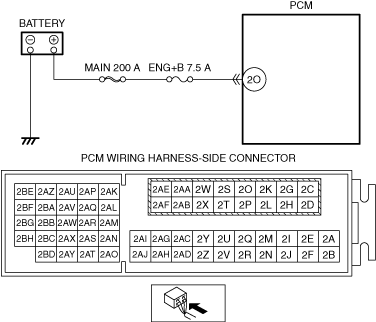DTC
U0301:09, U0401:00
Abnormal message from PCM
DETECTION CONDITION
• Correct data cannot be received from PCM
FAIL-SAFE FUNCTION
• U0301:09
-
― Illuminates the Mazda Radar Cruise Control (MRCC) warning light.― Inhibits the Mazda Radar Cruise Control (MRCC) control.
• U0401:00
-
― Illuminates the TCS/DSC indicator light*1, Mazda Radar Cruise Control (MRCC) warning light*1*2, and Smart Brake Support/Smart City Brake Support (SBS/SCBS) indicator light (amber)*1*2.― Tire pressure monitoring system warning light*2 illuminates after flashes. (Not illuminated/flashed depending on malfunction content.)― Inhibits the TCS*3, DSC*3, vehicle roll prevention function*2*3, Hill Launch Assist (HLA)*3, TPMS*2*3, Secondary Collision Reduction (SCR)*2*3, Mazda Radar Cruise Control (MRCC)*2*3, Smart Brake Support (SBS)*2*3, and Smart City Brake Support (SCBS)*2*3 controls.
*1: Not illuminated depending on malfunction content.
*2: If equipped.
*3: Control enabled depending on malfunction content.
POSSIBLE CAUSE
• DTCs are stored in the PCM
• DTCs are stored in the TCM
• Short to ground or open circuit in backup voltage circuit
-
― Short to ground in wiring harness between MAIN 200 A fuse and PCM terminal 2O― MAIN 200 A fuse and/or ENG+B 7.5 A fuse malfunction― Open circuit in wiring harness between battery positive terminal and PCM terminal 2O
• PCM malfunction
• TCM malfunction
